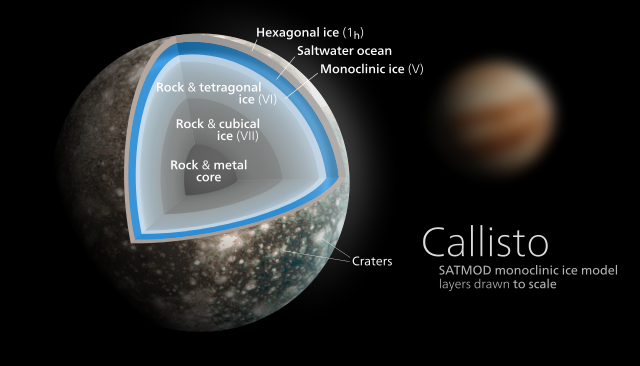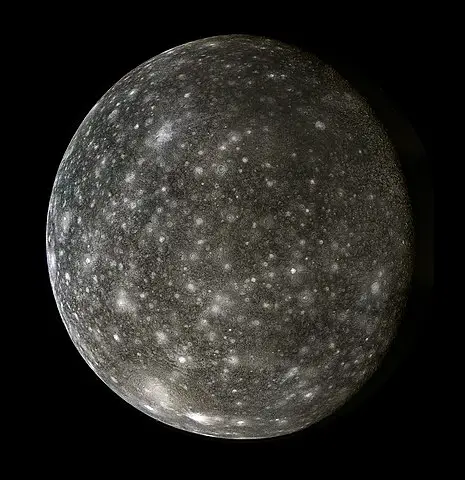Callisto or Jupiter IV, is the second-largest moon of Jupiter, after Ganymede. In the Solar System, it is the third-largest moon after Ganymede and Saturn’s largest moon Titan, and as large as the smallest planet Mercury.
Callisto is, with a diameter of 4821 km, roughly a third larger than the Moon and orbits Jupiter on average at a distance of 1883000 km. It is the outermost of the four Galilean moons of Jupiter, which were discovered in 1610, it is visible from Earth with common binoculars.
The surface of Callisto is the oldest and most heavily cratered object in the Solar System. Its surface is completely covered with impact craters. It does not show any signs that geological activity, in general, has ever occurred, and is thought to have evolved predominantly under the influence of impacts.
Callisto is composed of approximately equal amounts of rock and ice, with a density of about 1.83 g/cm3, the lowest density and surface gravity of Jupiter’s major moons. Compounds detected on the surface include water ice, carbon dioxide, silicates, and organic compounds. Callisto may have a small silicate core and possibly a subsurface ocean of liquid water at depths greater than 100 km.
The likely presence of an ocean within Callisto means that it could harbor life.
Various space probes have studied Callisto. Because of its low radiation levels, Callisto has long been considered the most suitable to base possible future crewed missions to study the Jovian system.

Facts
Callisto is also known as Jupiter IV
Callisto has first recorded observation by Italian astronomer Galileo Galilei in 1610
Callisto has a diameter of 4821 km, roughly a third larger than the Moon
It is Jupiter’s second-largest moon.
It is also the third largest moon in the Solar System and nearly the size of Mercury.
The King of the Gods of Greek Mythology was Zeus and Callisto was a nymph who was one of the mistresses of Zeus.
It orbits Jupiter in 17 days and on average
Callisto covers a distance of 11,829,191 km during each orbit
It orbits Jupiter on average at a distance of 1883000 km
Callisto is the outermost of the four Galilean moons of Jupiter
The surface of Callisto is the oldest and most heavily cratered object in the Solar System
Its surface is completely covered with impact craters
The diameters of the impact craters can range from 0.1 kilometers to over 100 kilometers.
The largest impact basin is Valhalla with a diameter of 1800 kilometers
The second is Asgard which measures about 1600 kilometers in diameter

The moon travels at an orbital speed of around 18,400 miles per hour
Galileo has detected evidence of a weak magnetic field which may indicate some sort of salty fluid below the surface.
Compounds detected on the surface include water ice, carbon dioxide, silicates, and organic compounds.
Callisto is surrounded by an extremely thin atmosphere composed of carbon dioxide and probably oxygen
Callisto’s rotation is tidally locked to its orbit around Jupiter so that it always faces the same direction
Callisto may have a small silicate core and
Callisto may also have a subsurface ocean of liquid water at depths greater than 100 km
Callisto is brighter than the moon – the layer of ice on the surface of Callisto reflects about 20% of the light that falls onto it.
Unlike other moons of Jupiter, Callisto doesn’t get affected by the orbital gravitational pull of the planet.
Scientists believe that the Callisto has been made by the slow accretion from the disk of the gas and dust that surrounded Jupiter after the planet formed about 5 billion years ago.
The craters and landscape on Callisto are never changed due to the lack of tectonic activity or volcanism that could alter the surface.
On Callisto, there are no large mountains, volcanoes, or other endogenic tectonic features
The radiation level at Callisto’s surface is equivalent to a dose of about 0.01 rem per day, which is just over ten times higher than Earth’s average background radiation
NASA has proposed a surface base on Callisto for future human exploration of the outer Solar System and the Jovian system.
The highest daytime temperature in Callisto is around -108C. At night temperatures are even colder at -193C.
Information
| Discovery | |||||||||
|---|---|---|---|---|---|---|---|---|---|
| Discovered by | Galileo Galilei Simon Marius |
||||||||
| Discovery date | 7 January 1610 | ||||||||
| Designations | |||||||||
| Pronunciation | /kəˈlɪstoʊ/ | ||||||||
|
Named after
|
Kallistō | ||||||||
|
Alternative names
|
Jupiter IV | ||||||||
| Orbital characteristics | |||||||||
| Periapsis | 1869000 km | ||||||||
| Apoapsis | 1897000 km | ||||||||
|
Semi-major axis
|
1 882 700 km | ||||||||
| Eccentricity | 0.0074 | ||||||||
|
Orbital period (sidereal)
|
16.6890184 d | ||||||||
|
Average orbital speed
|
8.204 km/s | ||||||||
| Inclination | 2.017° (to the ecliptic) 0.192° (to local Laplace planes) |
||||||||
| Group | Galilean moon | ||||||||
| Physical characteristics | |||||||||
|
Mean radius
|
2410.3±1.5 km (0.378 Earths) | ||||||||
|
Surface area
|
7.30×107 km2 (0.143 Earths) | ||||||||
| Volume | 5.9×1010 km3 (0.0541 Earths)[ | ||||||||
| Mass | (1.075938±0.000137)×1023 kg (0.018 Earths) (1.463 Moon’s) (0.168 Mars’) | ||||||||
|
Mean density
|
1.8344±0.0034 g/cm3 (0.333 Earths) | ||||||||
|
Surface gravity
|
1.235 m/s2 (0.126 g) | ||||||||
|
Moment of inertia factor
|
0.3549±0.0042 | ||||||||
|
Escape velocity
|
2.441 km/s | ||||||||
|
Synodic rotation period
|
synchronous | ||||||||
|
Axial tilt
|
zero | ||||||||
| Albedo | 0.22 (geometric) | ||||||||
|
|||||||||
|
Apparent magnitude
|
5.65 (opposition)[7] | ||||||||
| Atmosphere | |||||||||
|
Surface pressure
|
0.75 μPa (7.40×10−12 atm) | ||||||||
| Composition by volume | ≈ 4×108 molecules/cm3 carbon dioxide; up to 2×1010 molecules/cm3 molecular oxygen(O2) |
||||||||

